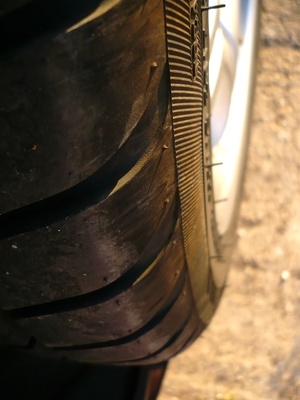
A couple scratches and your alloy wheels look trashed, and you're hopping mad. Sure, you could take your vehicle to the auto body shop, but spend an afternoon buffing out the scratches yourself to save on cash and have a reminder to be patient next time you're rushing to get out of a parking spot. Repair basic scuffs yourself in a few hours, but leave gouges or anything that damages your rim to the pros. The job goes faster if you work on a warm, sunny day.
Pour paint thinner into a bowl and dip a tack cloth in this. Dab the wet tack cloth on the scuffed area to cleanse the scuffed part of your alloy wheel. Rub the area with paint thinner, then re-wet your tack cloth and rub some more until all scuffed areas are completely clean. Don't clean the rest of the wheel, just focus on the scuffs.
Tape off the wheel so you don't get tape on that, using masking tape. Do several layers of tape to get the best coverage. You need only tape the side where the scuffs are, not the circumference.
Run 240-grit sandpaper over the scuffed area, rubbing back and forth until you've sanded out the scuff. Remove the wire from the steering knuckle and have your assistant hold the knuckle in place while you slide the bottom of the strut onto the knuckle. Line up the holes and install the bolts. Install the nuts and tighten them to 90 foot-pounds. Tighten the three nuts on top to 30 foot-pounds. Mount the brake line bracket and ABS bracket to the strut and tighten the bolts.
Fill in the sanded area with a scratch filler putty, applying it with an old sponge. Wait for the putty to dry, then coat the scuffed area with spot putty, applying a thin, even layer. Wait for the spot putty to dry before continuing. You'll get the best drying action on a hot, clear day.
Sand over the spot putty with 400-grit sandpaper, until the area feels smooth to your touch and no longer sticks out. To get a super-smooth finish, wrap your 400-grit sandpaper around a pencil or small piece of wood to create a mini sanding block. Stop sanding when the area you've been working on feels smooth and blends with the alloy wheel.
Throw a tarp over your car to cover it before moving on. Also tape off the rest of the wheel and anything else you don't want to paint by accident. Double-check before continuing to make sure you've covered everything. You should have only the scuffed part of the wheel showing.
Spray the damaged area with silver wheel lacquer, trying to get one even coat. Don't spray so much that the paint drips. Allow the silver lacquer to dry the recommended wait time, which is written on the back of the container. If you're new to spray paint, practice first using an old sheet of newspaper until you're confident you can spray without creating a mess.
Spray clearcoat, which gives alloy wheels their shiny look. Apply one coat of clearcoat in the same way as you did the lacquer; let it dry for 30 minutes. Apply a second coat just like the first.
Buff the newly painted area with either 1500 or 2000-grit sandpaper, which is very fine. Run the sandpaper over the clearcoat to bring out the luster and remove any imperfections in your spray job.
Pour a dime-sized amount of polishing compound on an old sponge. Rub the polishing compound over the area, working in concentric circles. Allow the polishing compound to cloud over, then wipe it off with a tack cloth.
Pull off the tape and tarp from your car and you'll be good to go with no noticeable scuffs.